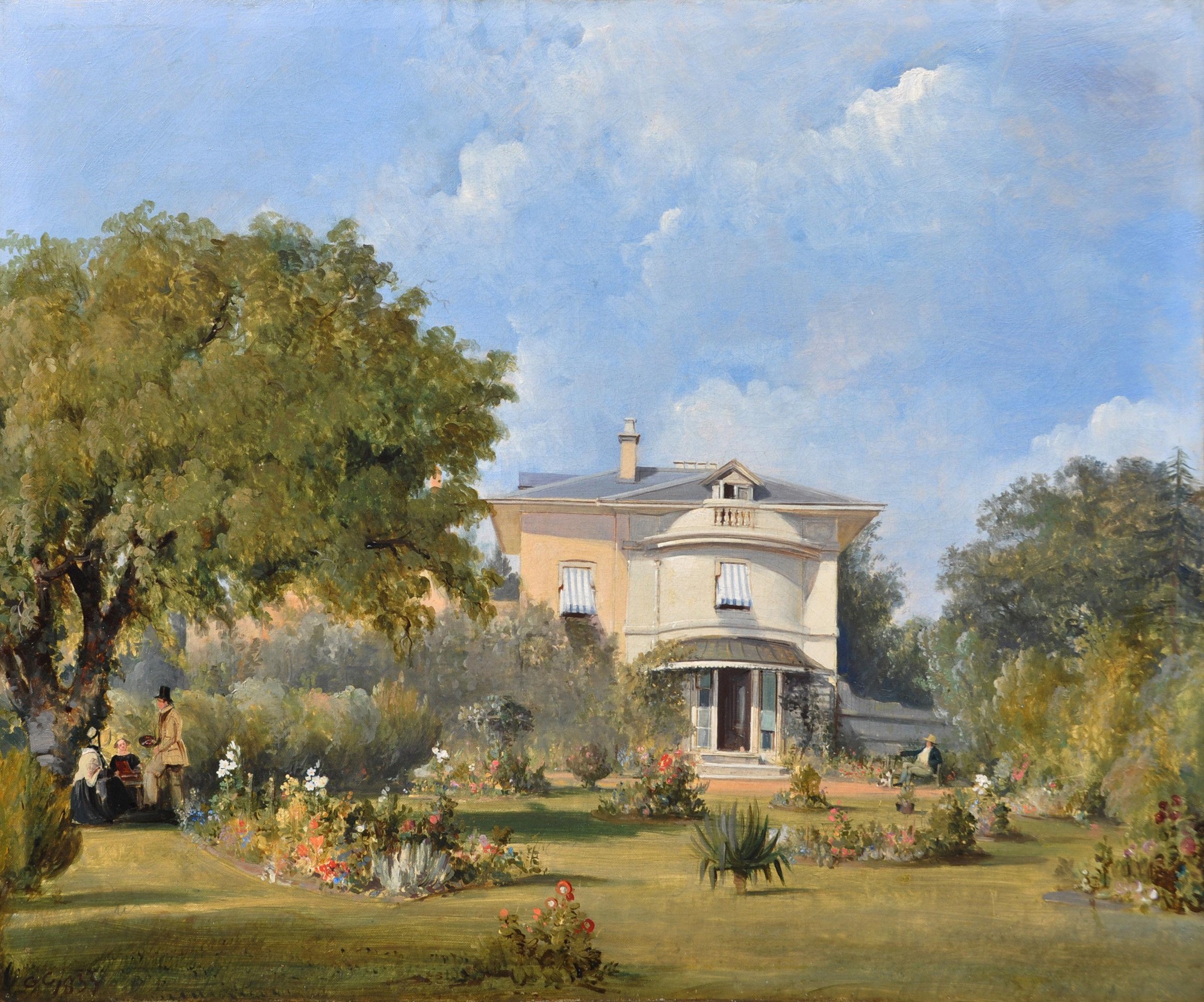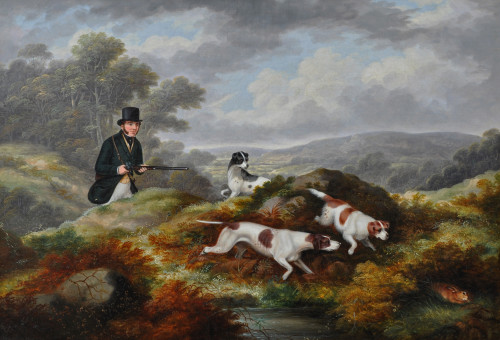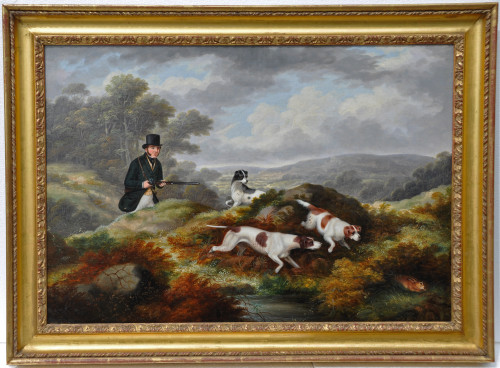The artist with family and friends in the garden of a Regency villa
The artist with family and friends in the garden of a Regency villa
GEORGE CHAMBERS SNR. OWCS
English School
1803-1840
The artist with family and friends in the garden of a Regency villa
Oil on canvas, signed with initials and dated 1833
20 x 24 inches
Overall framed size 60 x 71.5 cms
235/8 281/8 ins
It was previously thought that Chambers had depicted himself with family and friends in the grounds of his own house at no. 6 Park Village West, sending his exhibits to the British Institution and Royal Society of British Artists for the 1834 exhibitions using that address.
However numbers 1-7 comprised a terrace so this cannot be the case. There are several villas in the same road and in the London County Council's Survey of London: Volume 21, the Parish of St Pancras Part 3: Tottenham Court Road and Neighbourhood, ed. J R Howard Roberts and Walter H Godfrey (London, 1949), pp. 153-155, it states: The "Villas" comprising Park Village West and Park Village East are important examples of the romantic element introduced into domestic architecture by John Nash. John Summerson says of them that "they were among Nash's very last works and are full of interest. The houses are very small and often charmingly planned. Some are 'Italian' some 'Gothic,' some affect a kind of châlet style. Building this essay in the picturesque compensated him for having to leave out the clusters of villas he planned for the park itself. Trees, water, fanciful gables and balconies-all the properties of the romantic village scene as illustrated in the almanacs and the keepsakes are here. . . During the last years of Nash's life and after his death the villages were completed by his pupil and successor, James Pennethorne….
Park Village West lies within a triangle, with Albany Street on the west and the Regent's Canal to the north-east, the Barracks in Albany Street being to the south. The villas are grouped round an irregular horse-shoe line that leaves and re-enters Albany Street.
Therefore, it could be a nearby house but at that time only numbers 12, 17, 18 and 19 had been built. No 12 is a possibility as it belonged Dr James Jackson and they certainly knew each other as Jackson was a naval surgeon and doctor to William IV, Chambers' patron. Indeed, it might well have been because of Jackson that Chambers moved to Park Village. The problem with ascribing it no. 12 though is that the two-storey bow at the rear is on the right of the house whereas this has been portrayed on the left and there are some other architectural differences. Artistic license possibly could be the reason for some alteration to give a more visually pleasing aspect to the painting. If it is not depicting a visit to Dr Jackson at no.12, it could be another residence in the vicinity as there was a considerable number of Regency villas in and around Regent's Park. It could be the residence of another unrecorded friend or perhaps a patron from the B.I., R.A. or the Royal Watercolour Society.
We are grateful to Raymond Osborne and Huon Mallalieu for their help in identifying the location portrayed in this painting.
In Alan Russett's biography, with its subtitle "The Sailor's Eye and the Artist's Hand", there is the appraisal that George Chambers has been under-appreciated in artistic circles and that he was possibly the finest marine painter of the 19th century.
To have become a significant and highly skilled painter was a considerable achievement when one considers his lack of opportunity at an early age. He was born in a very squalid part of Whitby in 1803, the son of a sailor father and a mother who let lodgings. The latter could not afford more than the one penny a week that was needed per pupil to educate both her sons so George and his elder brother John attended on alternate weeks. However, his education only lasted until he was eight years old when he had to leave so as to go to work.
Initially he was employed, at two shillings a week, on the coal sloops in Whitby harbour where his job was to hold open the coal sacks while they were filled. Two years later he went to sea on one of his uncle's Humber Keels, the Experiment, a type of vessel directly descended from a Saxon 5th century design, which due to its shallow draught, could work close to shore and in coastal inlets. It was said that he was such a small child that he used to sleep in one of the sea boots of his uncle and his diminutive stature made him the victim of bullying in addition to the unforgiving conditions aboard during his life at sea. At the age of twelve, his father managed to get him apprenticed to the brig Equity commanded by Captain Storr which traded in the Baltic and the Mediterranean.
The boy had an innate desire to draw and his natural ability to do so was noticed by the Captain who put him to work painting the ship's buckets and producing sketches of passing ships. Storr encouraged him and made vague promises to release him from his contract at sea to pursue his talent. However, the captain procrastinated but, because of his boasting of his cabin boy's ability, word had got out among the sailing fraternity and when the Equity moored in London docks alongside the Sovereign, Chambers' life-changing opportunity came. Storr had been invited aboard the Sovereign by Captain Braithwaite for a drinking session and the latter persuaded Storr to arrange to let the aspirant artist go from his indenture. This came to pass and Chambers was free to pursue his passion.
He returned to Whitby by working his passage and found employment in a business specialising in painting ships and houses. He would decorate the hulls of docked ships and paint the letters of their names and was so good at this that some of the owners and captains would ask him to make oil paintings of drawings that they had made on their travels, and, as some of these were from the Greenland whale fishery, he depicted their vessels among icebergs. Encouraged by the increase in these commissions, Chambers decided that he needed to hone his technique and took the only formal training of his life from somebody called Bird who was a drawing master living in Whitby.
His mother died in 1820 and this seems to have been the catalyst for him to decide to leave Whitby, a place of which he had apparently tired. He had a married sister living in London so worked his passage again on a ship headed there and boarded with her.
Chambers had a stroke of great fortune through the Waterman's Arms in Wapping, a popular drinking haunt of colliers' crews which was owned by Christopher Crawford, an ex-collier from Whitby. A sailor had mentioned Chambers' name to Crawford who then sought out the artist, commissioning him to paint a view of Whitby which had to include vessels in which Crawford has served. When completed and hanging in the pub, it immediately attracted a lot of interest and other commissions ensued including one by Thomas Horner who was the proprietor of the Colosseum in Regent's Park and needed an assistant to help him paint The Great Panorama of London, a project that took several years to complete. He also worked as a scene painter between 1830 and 1831 at the Pavilion Theatre in Whitechapel.
The next stage of his career came about fortuitously in about 1830 when two of his paintings which were hanging in the window of a framer in Greek Street, were spotted by Captain the Hon. Thomas Capel R.N. who recognised both their painterly quality and nautical accuracy. The Captain bought both of them and recommended Chambers to his friends and fellow naval officers such as Admirals Mundy and Kerr, the latter writing of a work that Chambers had produced for him that: "I am very much gratified by the painting you have done for me - it is full of genius…The rain, the clouds, the light and the shade are all executed in the most skilful manner". This marked upturn in his professional career enabled him to afford to move into apartments off Bedford Square.
In September 1831 Kerr requested Chambers to send him some more paintings that he intended to submit to William IV for his approval and consequently the King purchased a painting of the opening of the new London Bridge. Chambers was also summoned to Windsor for an audience with the King and Queen Adelaide.
George Chambers seems to have suffered almost his whole life from ill-health, possibly a legacy of his impoverished background and polluted work place as a child. In 1833 he made a tour of the south coast to get some clean sea air which he hoped would aid a recovery. He visited Brighton, Shoreham and Lewes in Sussex and upon his return to London, he moved to 6 Park Village, West Albany Street in Regent's Park which his biographer John Watkins - who had first met him in Whitby in 1832 - wrote in his work Life and career of George Chambers - that this new residence "… combined the advantage of a town residence with country air".
Watkins also gave an intriguing and detailed description of Chambers' working practice at his new home: "He painted in his drawing-room; but excepting the picture on the easel, there were no marks of its being a painting-room. His colours and brushes were kept in a mahogany case, designed by himself and having the appearance a piece of drawing-room furniture… He rose about eight, breakfasted, went into his painting-room, worked and received visitors while at work, dined late - for he wished to prolong his working hours until light failed - and when profitably engaged would disregard all calls to dinner. Tea followed shortly after dinner, and if he had had a successful day, but more commonly when unsuccessful, he would indulge himself in a visit to the theatre. His habits were very domestic. He loved to chat with his friends round his own fireside, smoking a cigar to a glass of white brandy.
His method of painting a picture was first to chalk in the subject, then pencil it, washing out the chalk marks. He first rubbed in the sky, afterwards the more prominent parts of the picture, but not piece by piece - he generally had the whole of the picture equally advanced, for he could not finish bit by bit. His method when at work was to paint a few strokes, then retire to see how they looked, return and rub them out with a cloth, or put in others, retire again and so on until he produced the effect which he saw in his 'mind's eye'. Sometimes he used his fingers and sometimes the stick end of his brush. His two boys drew in the same room while their father painted. His wife, like the dark-eyed Kate of Blake, cleaned his brushes for him and passed her opinion upon his performances."
Apparently he usually was working on several pictures at the same time which caused Chambers to lament that he had to "paint for the pot" constraining him in the time that he could spend on each work. He was keenly aware of his surroundings and this was translated into his paintings in that the smallest details could be incorporated into the work which, while maybe not discernible on a cursory viewing, would become apparent later, enhancing the appreciation, depth and sophistication. He always carried a sketchbook with him and Watkins writes that: "I thought that a painter of his eminence would only take grand views but he would stop and book an old buoy, a post, or a rock. He said these would all be of great service to him in the composition of a picture."
He travelled to Holland a couple of times interspersed with further trips to the English coast for remedial purposes and his doctor advised him that he needed sun to improve his condition. In August 1840, he made the journey in the packet 'Dart' to Madeira but stayed there for only ten days, apparently missing his family too much. His condition deteriorated further upon his return and he finally succumbed to tuberculosis in Brighton on 28th October 1840.
George Chambers was certainly one of the most important marine painters of the 19th century who, like the eighteenth century Charles Brooking who also came from a disadvantaged background and was regarded by his peers as one of the finest marine artists of all time, was revered by his fellow artists. An example of the esteem in which Chambers was held in the artistic fraternity was when another major marine painter of the time, Clarkson Stanfield, shortly after Chambers' death, completed an unfinished work on the late artist's easel so that it could be sold to benefit Chambers' widow. J M W Turner also contributed to a fund for her.
In common with many English marine painters, George Chambers was influenced by the major 17th century artist Willem van der Velde the Younger, in particular the master's depictions of small craft sailing through choppy waters of which the work in the National Gallery, "A small Dutch Vessel close-hauled in a strong Breeze" is a fine example. However where the former differs from the 17th century master is in his use of perspective. Van de Velde and his 18th century followers used isometric perspective whereby a drawn ship can be reproduced in the finished oil at any distance. While technically correct, in reality one does not see a ship in the near foreground in this way which can make the painting seem a little stiff and contrived. Chambers, like J M W Turner, espoused viewer's perspective which is why their works have so much vitality.
He was equally adept in watercolours as in oils and it was for the former for which he received his only official recognition in his lifetime and he was made an Associate Member of the Old Watercolour Society in 1834 writing: "I was last week elected an associate of the Old Water-Colour Society, which is almost as being a Royal Academician". He was elected a full member of the OWCS the following year.
His oeuvre comprised marines and some landscapes which were as much studies of nature with their depiction of the light and movement in the sea, sky and trees as they were a record of a particular place. Other works, often commissions or ones done for specific exhibitions, were more exact portrayals of the place or event with precise rendering of the buildings or ships busy with workers or sailors or even large crowds and were popular with his contemporary buying public. He is now best remembered for his fine records of naval engagements which were technically complex. He employed fluid brushstrokes and was able to depict buildings, waterfronts etc with economical and deft brushstrokes, displaying his consummate skill.
He exhibited three times at the Royal Academy, fifteen at the British Institution, twenty-eight at the Royal Society of British Artists, forty-one at the Old Watercolour Society and three at the New Watercolour Society. Examples of titled works include: "Greenwich Hospital from the East", "Fire at the Theatre, Shake Lane 1823", "HMS Britannia entering Portsmouth", "The Capture of Puerto Bello", "Battle of Camperdown, 1797", "Rotterdam" and "Dutch East Indiaman weighing anchor". His work can be seen in the National Maritime Museum (11), Tate Britain, Victoria and Albert Museum, British Museum, National Gallery of Ireland, National Galleries of Scotland, National Library of Wales, Royal Collection, Portsmouth Museum, Nottingham Castle Museum and Art Gallery, Sheffield Museum, Whitby Museum, Southampton Art Gallery, Pannett Art Gallery, Harris Museum and Art Gallery, Preston Park Museum, Birmingham Museum, Wolverhampton Art Gallery, Margate Old Town Museum, Bury Art Gallery, Cambridge University, Government Art Collection, Hampshire Cultural Trust, Ferens Art Gallery, Rotherham Heritage Services, Williamson Art Gallery and Museum, Herbert Art Gallery and Museum, The Hepworth Wakefield, York Museum, Wisbech and Fenland Museum, Glynn Vivian Art Gallery and Seattle Gallery of Art.
Bibliography:
George Chambers, 1803-40: His Life and Work - Alan Russett
Dictionary of Sea Painters - E H H Archibald
Dictionary of British Landscape Painters - M H Grant
Dictionary of British Marine Painters - Arnold Wilson
The Dictionary of Victorian Painters - Christopher Wood
Marine Painting in England 1700-1900 - David Cordingly
Yorkshire Artists - Harry Turnbull
Watercolour Painting in Britain, the Romantic Period - Martin Hardie
Dictionary of British Watercolour Artists up to 1920 - H C Mallalieu
British 19th Century Marine Painting - Denys Brook-Hart
Dimensions:
1803 - 1840
Oil on canvas
England
signed with initials and dated 1833
RELATED ITEMS


























